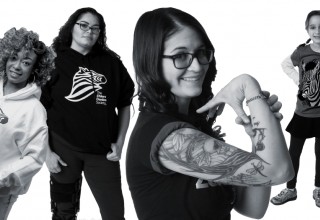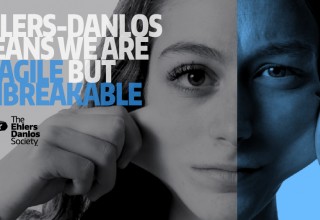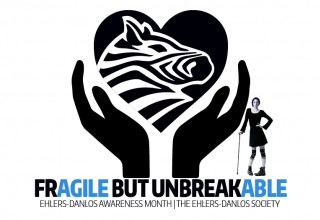
Baltimore, MD, May 2, 2018 (Newswire.com) - Spring is a time of renewal. For those living with one of the rare, primarily heritable, connective tissue disorders which comprise the Ehlers-Danlos syndromes (EDS) and the hypermobility spectrum disorders (HSD), winter can be the most painful and debilitating part of the year — and May, with its Ehlers-Danlos Awareness Month, rarely arrives soon enough.
“Ehlers-Danlos Awareness Month strengthens our community by raising awareness about EDS, HSD, and the related medical conditions our community too frequently endure,” states Lara Bloom, International Executive Director of The Ehlers-Danlos Society, a global nonprofit organization headquartered in Baltimore, Maryland.
Ours is a fight to improve access to better, earlier diagnoses, effective treatment options, and ultimately, new standards of care for EDS, HSD, and related conditions ranging from unstable joints, chronic pain, and poor wound healing, to migraines, mast cell activation disorder (MCAD), vascular, autonomic, neurological, and gastrointestinal complications.
Lara Bloom, International Executive Director of The Ehlers-Danlos Society
“Ours is a fight to improve access to better, earlier diagnoses, effective treatment options, and ultimately, new standards of care for EDS, HSD, and related conditions ranging from unstable joints, chronic pain, and poor wound healing, to migraines, mast cell activation disorder (MCAD), vascular, autonomic, neurological, and gastrointestinal complications,” continues Bloom, an EDS patient herself.
“For too long, patients have been forced to wait years, even decades, for proper diagnosis. In the past three years, our progress has been exponential. With the 2017 EDS classification, health professionals now have the criteria necessary for more accurate diagnoses and more consistent management and care,” Bloom adds.
Dr. Clair Francomano, director of The Ehlers-Danlos Society Center for Center for Clinical Care and Research at the Harvey Institute of Human Genetics, Greater Baltimore Medical Center, and chair of The Ehlers-Danlos Society’s medical board, adds: “With the energy, commitment, and generosity of our donors, medical professionals, and the entire Ehlers-Danlos community, we’ve finally achieved a critical mass in Ehlers-Danlos research, where it is now possible to make dramatic leaps in our understanding of EDS, HSD, and myriad related disorders affecting our patients.”
“In launching our ‘Moonshot’ to discover the genomic underpinnings of hypermobile EDS, the International Patient Registry, numerous global research collaborations, ambitious new medical education programs, regular medical and scientific symposia, and an ever-growing number of learning conferences for those living with EDS and HSD, our community is finally moving forward.”
For this year’s Ehlers-Danlos Awareness Month, the Society seeks to better connect its community to each other, to their caregivers, and the world at large, through social events, awareness activities, and rallies to be held from Austria to Australia, under the theme #FragileButUnbreakable. “Individually, our bodies may be ‘fragile.’ But, together, with the support of our loved ones, our community, and our health professionals, we are ‘unbreakable’ in spirit,” states Shani Weber, Local Groups & Outreach Liaison for the Ehlers-Danlos Society.
ABOUT THE EHLERS-DANLOS SOCIETY
The Ehlers-Danlos Society is a global community of patients, caregivers, healthcare professionals, and supporters, dedicated to saving and improving the lives of those affected by the Ehlers-Danlos syndromes, hypermobility spectrum disorders, and related conditions.
A 501(c)(3) nonprofit organization with offices in the U.S. and the U.K., we support collaborative research, education, advocacy, community-building, and care for people with EDS and HSD.
The Ehlers-Danlos Society seeks to grow worldwide awareness — and a better quality of life for all who suffer from these conditions. Research is at the center of what we do, so that one day we will have a cure.
ABOUT THE ZEBRA
Patients with Ehlers-Danlos syndromes are often referred to as “zebras,” which references a popular medical school mantra, “When you hear hoofbeats, think horses, not zebras,” equating zebras with rare diseases. In the wild, a group of zebras is called a dazzle. The #DazzleTogether campaign encourages the community to work together as a “dazzle” to raise awareness and funds for research throughout the month of May.
ABOUT THE EHLERS-DANLOS SYNDROMES AND HYPERMOBILITY SPECTRUM DISORDERS
The Ehlers-Danlos syndromes (EDS) are a group of 14 heritable connective tissue gene disorders that produce a spectrum of complex problems across multiple systems of the body. The physical characteristics that are common to all types of EDS include hypermobile joints, skin hyperextensibility, and tissue fragility. EDS are known to affect more than one in 5,000 men and women, of every race and ethnicity.
Each person’s case of Ehlers-Danlos syndrome is unique. Severity may range dramatically, even within families. Prognosis depends on the type of Ehlers-Danlos syndrome and the individual.
Hypermobile Ehlers-Danlos Syndrome (hEDS)
Hypermobile EDS (hEDS) typically begins with extreme joint hypermobility, joints which can stretch beyond normal limits; a propensity for sprains, strains, subluxations, and dislocations; pain, often in lower limbs, and with fine motor or repetitive tasks; and easy fatigability.
Although each person with hEDS faces their own set of problems out of the wide range of possible effects, hEDS generally evolves over time. The initial “hypermobility” phase may involve the ability to hyperextend various body parts to extremes normally attributed to contortionists, gymnasts, or elite dancers. Over time, the extreme hypermobility and connective tissue instability of hypermobile EDS may lead to permanent injuries. The “pain” phase involves widespread and worsening pain and headache; pelvic pain in women; and worsened fatigue. The “stiffness” phase seen in some adults and in the elderly results in general reduction in joint hypermobility; significant losses in functionality because of disabling pain and fatigue; and increased limitations, due to reduced muscle mass and weakness, prior injuries, and arthritis.
While certain features of hypermobile EDS are not yet in the diagnostic criteria — as more research is needed to prove causation and the relationships between the hEDS and potential comorbidities — clinical descriptions of hEDS have expanded beyond joint hypermobility to include: chronic pain and fatigue, gastrointestinal disorders, neurological issues, dysautonomia, and anxiety. As of this time, hypermobile EDS has no identified distinctive cause.
Hypermobility Spectrum Disorders (HSD)
The hypermobility spectrum disorders (HSD) describe patients with symptomatic joint hypermobility not corresponding to other known conditions. The spectrum of HSD ranges from secondary musculoskeletal manifestations, and a simplified categorization of genetic syndromes featuring joint hypermobility.
Vascular Ehlers-Danlos Syndrome (vEDS)
Life expectancy can be significantly shortened for those with the Vascular Ehlers-Danlos syndrome (vEDS) due to the potential for organ and/or blood vessel rupture. While significantly diminished life expectancy is not usually a factor in the other types, quality of life can be severely affected by chronic pain, disability, and myriad comorbidities. There are no cures for the Ehlers-Danlos syndromes, but there are treatments which address many symptoms and preventative measures that may help slow their progression.
Source: The Ehlers-Danlos Society
Share:



